Chapter 19. Evolution on the Main Sequence
19.1 Introduction

Author: Kristin Miller
Editor: Grace L. Deming, University of Maryland
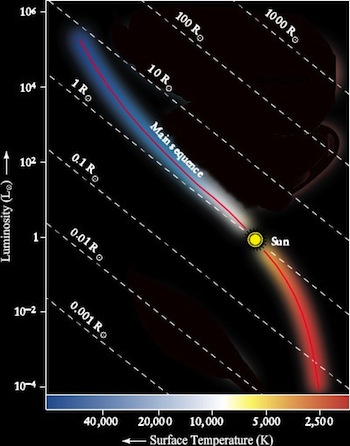
The goals of this module: After completing this exercise, you should be able to:
- Predict how long a star of a certain mass will remain on the main-sequence.
- Explain the theoretical sequence of events that occur in the core of a high-mass star just before it becomes a supernova, and the key physical processes that drive them.
- Describe how changes in the core of a main-sequence star affect the star's outer layers.
In this module you will explore:
- How the very nature of the fusion process forces the core of a star to change.
- Why the main-sequence line on an H-R diagram is actually a band with finite thickness.
Why you are doing it: The main-sequence phase of evolution is the longest portion of a star's life in which fusion actively provides its energy. For this reason, the majority of all stars we see (including our own Sun!) are main-sequence stars as shown in the H-R diagram to the right. Understanding the changes that occur inside a star during this important phase of its life gives us insight into the changes we observe in the Sun and literally billions of other stars.
19.2 Background
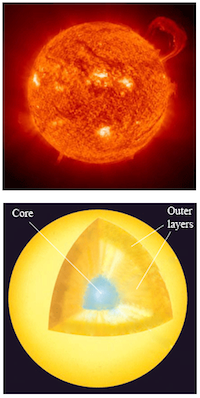
In this activity, we will study the physical changes that occur inside a star during its main-sequence lifetime. Keep in mind that these changes are small and gradual, and do not represent a new phase in the star's evolution! They simply reflect the fact that stars do not suddenly cease to evolve once they reach the main sequence.
The main-sequence phase is one of the most important phases a star goes through. It is one of the longest and most stable phases for a star. The main sequence phase is the most likely time that life could develop on any planets the star may have. This is the phase our Sun is currently in, which makes it of particular interest to us. Before we examine what happens to a star during this phase, let us first look at what defines a main-sequence star.
The main-sequence phase of a star's life is defined by three properties. First, main-sequence stars all fuse hydrogen into helium in their cores. The exact reactions through which this is accomplished and the exact details of the process differ for stars of various masses, but the fusion of hydrogen into helium is one of the basic characteristics all main-sequence stars share. Second, main-sequence stars are in hydrostatic equilibrium. This means that the outward push of pressure (due to both radiation and the movement of gas particles) is exactly balanced by the inward pull of gravity at every point within the star. Third, main-sequence stars are in thermal equilibrium. This means that the amount of energy produced in the core of the star each second is exactly balanced by the amount of energy radiated away from the star's surface (its luminosity). These two equilibria together mean that the main-sequence phase of a star's life is a stable phase; in other words, the star is neither rapidly contracting or expanding nor rapidly heating or cooling - it is in balance.
19.3 Main-Sequence Lifetime
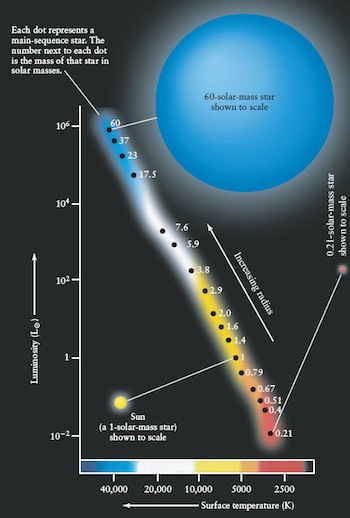
Protostars of different masses require different amounts of time to become main-sequence stars, so it should not surprise us that stars stay in the main-sequence phase for differing amounts of time as well. In fact, the main-sequence lifetime of a star depends on its mass when it first enters this phase. More massive stars have shorter main-sequence lifetimes, and less massive stars have longer main-sequence lifetimes, just as more massive protostars take less time to reach the main sequence than their lower mass counterparts. To see why this is so, we need to understand the processes that determine how long a star can remain in the stable state known as the main sequence.
One of the defining characteristics of a main-sequence star is hydrogen fusion in the core. When all of the core hydrogen has been consumed, the star will no longer be a main-sequence star; it will move on to the next stage of its evolution. Hydrogen fusion supplies the energy the star needs to sustain hydrostatic and thermal equilibriums. The more hydrogen a star has, the more fuel it has to burn to produce the energy it needs to survive, so a star’s lifetime is related to the amount of hydrogen it has. So first we need to think about how we can find out how much hydrogen a star has.
Question Sequence
Question 19.1
8Ohw4eSVGA8m/fF+T9hOK0wTlJDwR1uOBFssdcZmhNJ/+m4W6sRzhnkTBBc6uQENmG4DbgYRuDkz1QGSkHAirSGAEFIC57iRYlAV1sGiHavnICf/NlXT5A6YSTHEyEk8dD8P0/zyIoSfIISwad0Yyce8cdA1O1pffU6TpW6B524JkBu9LCD6XhwC7RT+1F7DNyDqYA==Question 19.2
DXnnKhZuvwnFR7v1anURDJR2eAZaSgRvzpfVUAnjRpRq/jedTk2q6tFlGu9wm/Bze5/eG8Z7o0OGlfayJYTZyZp2G5C6Mv09of78/wWP0qYHxwikI+9BpEaJjJ2O6Z6G7dlw8rA4m/rAYAlmXl96dhjzWv8DqLWP9RweaAMxCt0j9n//k7/vK5peCCkN7v9ZhKvFtBdjJE6acHM+HbymiL6M/F1WfVuXdN3BNhWuEy3iuCeRi+JUXIPb8cs=Summary
So far, we have seen that a larger mass would suggest a longer lifetime because larger mass means more hydrogen is available to fuse. We have also seen that a larger luminosity would imply a shorter lifetime because large luminosity means a star is consuming its fuel very rapidly. Let's see if we can figure out which of these factors is the more important.
We can combine these two factors as follows:
Lifetime ~ M/L
Where M represents a star's mass and L represents its luminosity. We can make this relationship even simpler by remembering that mass and luminosity are related for main-sequence stars. On the main sequence, a star's luminosity is proportional to its mass raised to the 3.5 power, as we can see in the following graph:
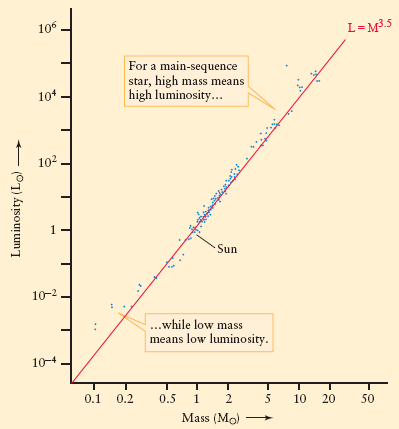
If we substitute L = M3.5 into our equation for a star's main-sequence lifetime, we find that:
Lifetime ~ M/L ~ M/M3.5 = 1/M2.5
This is an amazing result! It tells us that the main-sequence lifetime of a star is determined solely by its mass when it reaches the main sequence.
Because lifetime is inversely proportional to mass, the more massive stars have much shorter main-sequence lifetimes than the lower mass stars. Even though these massive stars have much more fuel than low mass stars, they burn through their fuel very quickly and thus stay only a short time on the main sequence.
19.4 Internal Changes

What happens inside a star during its stay on the main sequence? We begin with changes that occur within the core of the star.
These graphs show how the amount of hydrogen has decreased, and the amount of helium has increased, in the Sun's core during its main-sequence lifetime due to fusion. The dashed line shows the Sun's composition when it first became a main-sequence star 4 ½ billion years ago. The amount of hydrogen will continue to decrease, and the amount of helium will continue to increase, during the remainder of the Sun's main-sequence lifetime - roughly another 5 billion years.
As the figure shows, a main-sequence star, like our Sun, begins its life with a core composition of about 74% hydrogen, 25% helium, and 1% heavier elements, but it doesn't stay that way! We know that this composition must change with time, because hydrogen fusion creates helium nuclei out of hydrogen nuclei. In fact, each fusion reaction converts four hydrogen nuclei into one helium nucleus. During its stay on the main sequence, the process of fusion gradually changes the core composition of a star until it is roughly 99% helium!!
How does the interior of a star respond when the core composition changes? Because fusion reactions result in a decrease in the total number of particles in the core, the gas pressure, which is due to the motions of all of the particles in the core, also decreases. This in turn causes the core’s radius to decrease since there is not enough pressure to support it at its original size.
To see what happens next, try changing the radius of the core in the following animation, and watch what happens both in the core and the outer layers of the star.

Question Sequence
Question 19.3
njMZA+N4Lr+TXbS5ARHVZMJKQg+itxNFfwDeEGDSzMCJ5ZEpD1Sip5J559UUpUKC8PI+/cdSAYEWCzFcMULywQvsyvpN0J5/NdH3HxYsREVUOytNDIn3p9xw+uRVcFugqG72CpvXIee6LTP0eK0/bZDhyjZyrFssM2diPBS3t4BeslaPYN05U6c7n2bloMHEc1iHVHQgw2PF/DpwjVw8LsUtdxjeKd8a9S8YkCDvazfUjtfrniub8sUHPy4AbuvhqSOfDqVhfLmSRjS9The decrease in pressure due to the decrease in the number of particles in the core temporarily upsets the balance between gravity and pressure in the star, and the core contracts under the influence of gravity until equilibrium is again restored. As it contracts, the pressure in the core increases, the density of the core increases, and the temperature increases as gravitational energy is converted into heat. The increase in pressure, density, and temperature in turn leads to an increase in the rate of the fusion reactions in the core. But, the increase in the rate of fusion means that hydrogen nuclei are being converted into helium nuclei increasingly faster, which means the gas pressure drops again, this time more quickly, and the whole cycle repeats. Thus, with time, the core of a main-sequence star becomes increasingly smaller, hotter, and denser, and it consumes its fuel at an increasingly higher rate.
An increase in the rate of hydrogen fusion in the core of a main-sequence star does not go unnoticed in the outer layers of the star! They must respond to the changes in the core in order to maintain hydrostatic and thermal equilibriums throughout the star. To see what happens, try the animation above again, and notice what happens in the outer layers of the star as you increase or decrease the size of the core.
Question Sequence
Question 19.4
Y1vi2rPkRkWmcoehh0PdVk24vtdkRkiJQrWeCOHtP+j62btXeGQqi6dQIcyk4YvPjM/QiPU1GbmcMyesE/dO2mkYtCZKDG9g3lsorwWaM6uF0+Z8wATPr7SC4sHKgJ9Zcc2eapG2O+py/Xp28ygYDeKkGVdKszgSEl2GJzT5qftsOKn/3cYBhsqyuibTzsq4M85VO7RYrvjLfJV3Y61jcVjrNXk=Summary
This increase in luminosity can be understood as follows: the higher rate of fusion in the star's core leads to an increase in the amount of energy that flows out of the core. In order to maintain thermal equilibrium, this increase in energy output must be balanced by an increase in the star's luminosity. The increase in energy output from the core also increases the radiation pressure throughout the star, which makes the outer layers swell. So, both the stellar luminosity and radius increase as the core of the star shrinks. Because surface temperature is related to luminosity and radius, it also changes over the star's main-sequence lifetime. So, as the core shrinks and heats up, the star expands and brightens, and its surface temperature changes accordingly.
19.5 The ZAMS and the H-R Diagram
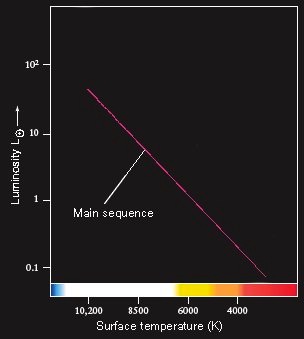
Changes in luminosity and surface temperature of a main-sequence star cause the characteristics of the star to change, so its location on the H-R diagram change from its initial position on the main-sequence.
Question 19.5
dAGHsbrLWqYvLvIAFRSieLgT43VJN2x1flZu0/aJiWUVOXYTxSMCen7zXRO4PpNS7YO6YL3Fuj96lYGF/2oAMGWBucZa6axYRCm04io9098JSDBg3upq376oCay/Xph5RdvpP78hWjLLvF7JLDqrsOeorSdc5KUGS64HCnHZCmnizlH0Oxo8xgRmOmU4UMdvZhsQmDTpx869luyZ/2EU1iOx3KZe6yydsA+EckWNe5kZgJbRPPyRRt/x3r4iMUsdZNd2/6rZg8DrU7WD4Xmw6UXYDjmqrqUHdSKuKKBIWeAmnK0GXLP/pPmH/rODYDG9qLTpnkX3IbFmIGYNEQ8QI/ZvcqZcsyZBaxhziSMlH/WvTV2ClEuQxbcQ9t9Zb+BARDTT4bHzoHtqxSHNm1D23WGZ5uk=Summary
On the H-R diagram, the initial position of a main-sequence star is along the lower edge of the main-sequence band. This line is known as the zero-age main sequence, or ZAMS. The ZAMS is the position of the stars that have just begun their main-sequence lifetimes. As stars evolve during the main-sequence stage, their changing luminosities and surface temperatures cause them to move up and over. The net result is that the main sequence is not a thin line of stars, but a band with finite width, as shown in the figure below.
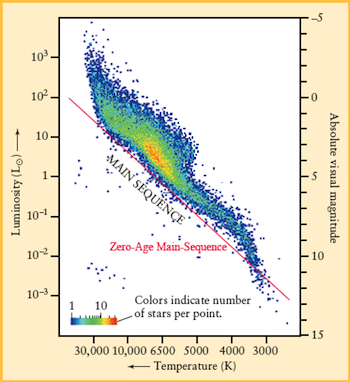
Keep in mind that these changes are small compared to the changes in luminosity and surface temperature that occur as a star evolves from one phase to the next. Our Sun, for example, is roughly half way through its main-sequence lifetime, yet it has increased its radius by only 6%, its luminosity by 40%, and its temperature by only 300 K; see the figure below.
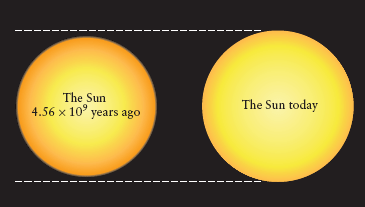
These changes are small but measurable, and remind us of the important changes taking place deep inside the Sun (and other stars like it) during its main-sequence lifetime.
19.6 Quick Check Quiz
Indepth Activity: Evolution on the Main Sequence